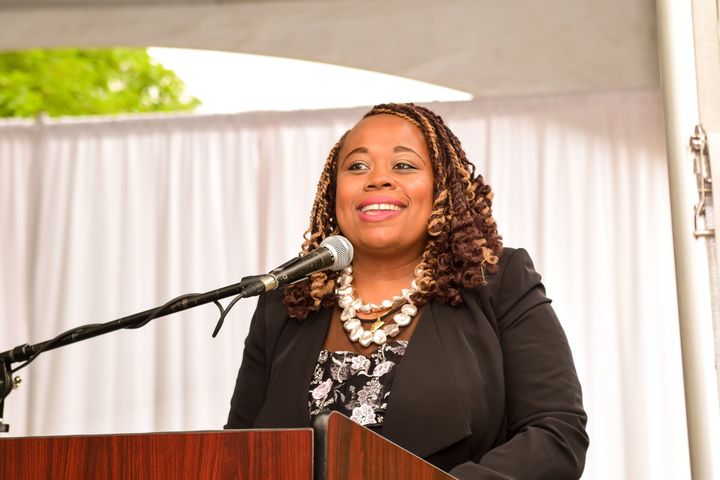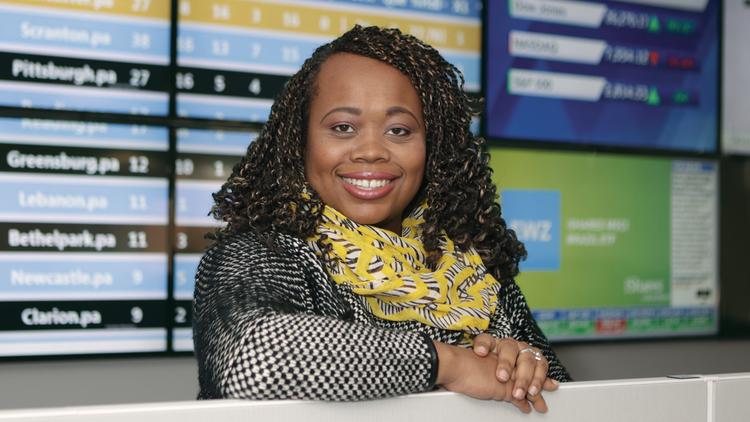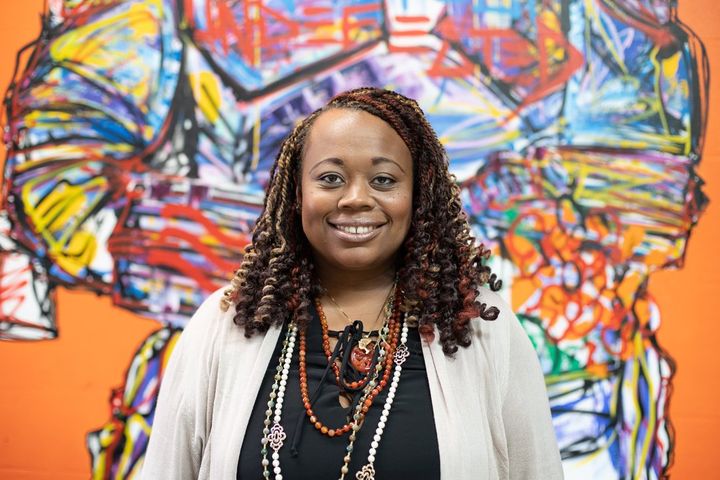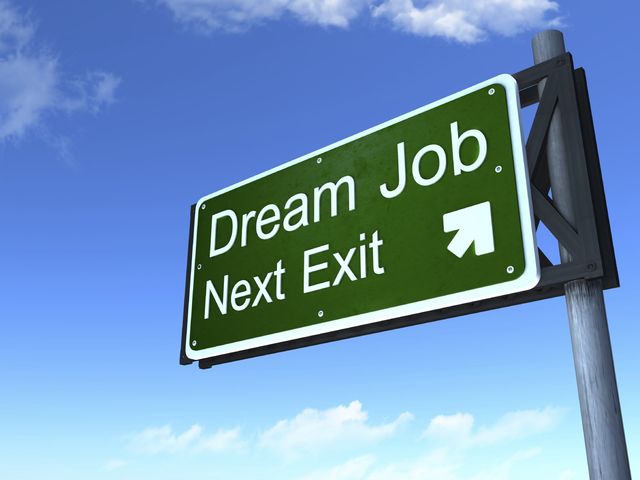Keynote Descriptions and Deliverables
As a Millennial leader, Toni Murphy has mastered the art of leadership by building great teams, being diverse and inclusive with her employees, and learning how to climb the corporate ladder rung by rung at a quick pace. She is dynamic, edgy, thoughtful and powerful in her approach to problem solve and help others soar to be their very best. Electrify your audience with one of Toni's standing ovation speeches.
All of the KEYNOTES below are also available for
Professional Development session delivery.
Contact Kelly@ToniMurphySpeaks.com for more information.
Over the last ten years, there have been a plethora of articles published on the achievement gap between men and women. From career advancement to wealth accumulation to assets and retirement, it is irrefutable that women generally lag their male counterparts. This fact is only exacerbated when you add the compounding dimension of race. Women account for more than half of the US population and we are still lagging behind men by more than 20% in the highest offices in the land -- and, women of color are literally a fraction of the total female percentage.
Again, this is no surprise. Yes, the glass ceiling is real and yes, sadly the concrete ceiling is worse than we originally thought. But there is a way to beat the odds. I am a living witness that despite all the challenges women (and women of color) face, we can rise. When we level the playing field, give women access to the "unwritten rules" and provide the same privileges as are afforded to men, women thrive and flourish.
Over the course of my career, I have been promoted 8 times, each time after 2-3 years in the role. I have been tapped for positions with greater scope and responsibility -- even roles outside of my functional expertise. This is how I was able to unlock my earning potential and career progression.
Certainly, intelligence and hard work are always going to be key differentiators, but I believe it is the intangibles -- knowing how to navigate the business, getting the right sponsors, and positioning oneself -- that ultimately make the real difference.
In this keynote, I will share what I have learned along that way so that you can be the jackhammer to the concrete ceilings impeding your growth. We will cover the following concepts and principles:
Not all jobs are created equal -- progressing your career faster by aligning your career ambition with the Company's key business objectives and growth areas
Finding the Right Executive Sponsors -- having 2 or 3 influential leaders who are willing to expend political capital and make room at the table for you
You CAN and MUST Influence Outcomes -- how to productively pursue your brand and influence how your boss and others see your potential (from performance reviews to stretch assignments to promotion and expansion opportunities)
Leveraging "coopertition" to find a competitive edge-- paying attention to and learning from those teammates who have power, influence, and top performance
By the end of our discussion, you will have a line of sight to the key adjustments you need to make in order to accelerate your career growth and earning potential.
Building Dynamic and Collaborative Teams
Over the course of my career, I have experienced all sorts of team dynamics. In some cases, I inherited a team that had been together for years. In other cases, I found myself building a team from scratch. Then, there were the teams that were highly functioning in terms of execution but low functioning when it came to problem solving, accountability and conflict resolution.
You would think that building a dynamic and collaborative team would be pretty simple... hire the right people with the right skill-set and they will work well together. Well, if that were the case, there would be more people vying to move into leadership. The truth is that building a great team is a lot of work and can be very exhausting.
I have learned that team-building is all about creating a productive environment where every team member feels valued for their contributions to the organization's goal. It requires thoughtful engagement, planning and trust-building along the way.
In this keynote, I will address how any leader can create a dynamic and collaborative team, regardless of whether the team is new, existing or in transition. The underlying principles of team-building are the same. We will cover these key fundamentals:
1. Creating a diverse & inclusive team with complementary skills and differing viewpoints
2. Leveraging the power of design-thinking to create your team's mission statement, vision and values
3. Understanding how personal preference can drive better team engagement and alignment
4. Avoiding the trust pitfalls (e.g. micro-aggressive behavior, not allowing for disagreement, "side-bar / water cooler" culture)
5. Recognizing that team-building is a journey, not a destination (e.g. how to continually feed and nurture the health of the team)
After attending this keynote address, your leaders will return to the business with greater understanding of how they can drive better team engagement, which will ultimately lead to better business results.
Accelerating Growth through Customer Experience
Over the course of my career, I have sat in countless business strategy meetings where company executives attempt to find ways to change the trajectory of their respective company's growth. Most often, that strategy focuses on the top-line -- growing revenues through new customer acquisition.
Until more recently, companies have just assumed that existing customers are just an unshakable base of loyalists.
The truth is, however, as technology proliferates and as business competition increases, customers are being presented more and more with new and sometimes better options for products and services.
In today's environment, there is absolutely no substitute for an exceptional customer experience. The customer experience must be your organization's best product.
This is a pretty simple concept; treat customers well and they will stay. The challenge is not the concept. The challenge is creating a culture where customer sentiment and loyalty is the new barometer for financial health. That means the company has to galvanize the employees and leadership differently in order to drive more customer-centric outcomes.
In this keynote, I will address how your company can make the pivot to a more customer-centric culture-- a culture where the customer is at the center of every critical business decision. We will discuss the following:
1. The cost of customer experience -- connecting the dots between customer sentiment and long-term financial performance
2. Top companies (USAA and Zappos) who have created a compelling vision around the Customer Experience
3. Understanding your customer data (through customer satisfaction and/or NPS surveys) to uncover key customer experience "blind-spots"
4. Knowing your clientele and driving operational efficiency -- there is a financial benefit to being "easy to do business with"
5. Reinforcing a customer-centric culture with clear alignment around goals, messaging and performance measures
6. Closing the customer experience loop -- engaging in customer call-backs, following up on open issues and learning from your mistakes
7. Rewarding the right behaviors and measuring your progress
Whether in the public or private sector, customer experience is becoming increasingly important to growth. Leaders who attend this session will have a greater understanding of what it takes to build a culture that focuses on the customer to drive business results.
Power of Authentic Leadership

My mother has always said, “The most powerful tool you have in life is your personal story.” It gives people a gateway into our beliefs and our values. It explains so much about us: why we think the way we think and why we do the things we do (even unconsciously). And the truth is when people understand our stories, they feel more connected to us, which in turn leads to long-lasting and trusting relationships -- both at work and in life.
Over my years of leading people, I have seen even the most thoughtful leaders struggle with making connections with their teammates. Some leaders shy away from sharing their personal viewpoints or even sharing their personal journey. They arrive at work every morning and lock the authentic version of themselves in the trunk of the car. They attempt to gain trust through appearances of authenticity and conviction but rarely are their viewpoints anchored or explained through the context of their personal journey. They want their teammates to follow without explaining the why behind the why.
In this keynote conversation, I will share what I believe are the key elements of
authentic leadership:
1. Unleashing the power of personal storytelling (e.g. identifying and sharing key teachable / "ah-ha" moments over the course of your life)
2. Leveraging those key moments to contextualize your leadership viewpoints (e.g. "It is because of this experience that I believe what I do.")
3. Deepen your relationships by authentically engaging others to tell their own stories - authenticity is contagious when we give people permission to be themselves. By the end of this discussion, the participants will feel more compelled than ever to
bring their authentic selves forward in every relationship in their lives.
Demystifying the Climb Up The Corporate Ladder

Over the years, I have served as a mentor to the high-potential talent in our organization. During our mentorship meetings, we touch on a range of topics but often, the focus of our conversation tends to be on navigating the labyrinth of the corporate environment. Mentors often ask me about how I have ascended the corporate ladder, but really what they are looking for is clarity on their own pathway.
I am asked probing questions: How do I make a name for myself in this organization? Why didn't I get the interview or the job? Why does it seem like I am being passed over? What will it take for me to be promoted?
As someone who has been promoted 8 times in less than 11 years within a Fortune 50 company, I have seen what works and I have a good sense of what it takes to get ahead. In this keynote conversation, I will demystify what it takes to survive and thrive in the corporate environment. The participants will learn these 5 things that will better influence their trajectory:
1. How to go from anonymous to remarkable using the "60/40 split"
2. Understanding the cultural nuances that lead to promotion — do you know the unwritten rules of your organization?
3. Seeking out the right feedback and knowing whose perspective ultimately matters
4. Decoding the organizational signals and becoming more politically savvy
5. Knowing your brand (e.g. What is being said about you when you are not in the room?)
Creating pathways to promotion are not easy but after hearing what I have done to climb the ladder rung by rung in record time, attendees will better understand organizational norms and be better equipped to position themselves within it.
Showing Up VS. Showing Out
When I was a kid, my mom would say to me and my siblings, "You are not here to show up, you are here to show OUT!" That was her way of saying to us that it was not good enough to blend into the crowd. She had a strong belief that we should exceed expectations, defy the odds and set a new bar that others could not reach. From our style of dress to our attitude and aptitude, just OK was NOT OK with her.
As I look back on my career, that quote has served me better than I could have ever imagined. Every time I started a new position, I was reminded of my mother's words and have applied that philosophy in order to get ahead.
In this keynote address, I will share what I believe are some key ways you can set yourself apart as a standout talent. Everyone is capable of being great, but embracing the "show out" mentality is a great way to solidify your brand as a rising star in your organization.
In this keynote, I will speak to the following:
1. Understanding your organization's cultural norms and setting a higher bar of "acceptable behavior"
2. Finding creative ways to gain access and notoriety (e.g. taking on stretch assignments with key decision makers)
3. Being good at telling your story (knowing your value, knowing your business, sharing your vision)
4. Picking your "spots" carefully (finding the healthy middle ground between being "overly ambitious" and being a "wallflower")
5. Study your organization's iconic figures: learning from their triumphs and, equally, their mistakes
Whether you are an extrovert or an introvert, this conversation is for you. Showing OUT is not about being pompous or arrogant or self-aggrandizing. It is about giving you the tools to step into your own light so that others can fully see and experience your greatness.
Unapologetically Young, Female and Black

When I started my career on Wall Street as an Investment Banking analyst, I was the only African American female on our floor. While I generally felt welcomed within my workgroup, I was always aware of my difference--so much so that I changed my style of hair and clothes to fit what I perceived as acceptable for a young woman in this particular corporate environment. Even as I grew in my career, there were times when I worried about how my difference would impact how others treated me. My age, gender and race were all center stage in this environment.
Over time, I have learned that I cannot control what others think of me. With lots of hard work, I learned to stop letting the voices in my head keep me from fully participating in and sharing my full potential.
In this keynote address, I will share how I have turned my feelings of "self-doubt" into anchors of great confidence. Attendees will experience the power of being unapologetic about who you are and treating your difference as your competitive edge.
We will discuss in detail the following:
1. Recognizing your limiting beliefs -- what holds you back from fully participating?
2. Harnessing the power of your difference
3. Learning to embrace who you are while managing the perceptions of others
4. Tokenism is real!
5. The challenge of representing a larger group while speaking only on behalf of yourself
Attendees will leave feeling energized and inspired, knowing that if they treat their diversity as a strength... it will benefit them exponentially.
Resilience and Stick-to-itiveness

I am so grateful for the opportunities that have been afforded to me in my career. Over my 15 years in the cable industry, I have worked in an array of cities and in a variety of corporate departments. Today, I lead a large team across a vast geography. Some would even characterize my career journey as "meteoric" because I have been promoted every 18-24 months with my current employer. On the surface, my career path looks very smooth.
While my career has been amazing, it has also been fraught with disappointment, closed doors, hard decisions and mistakes. I remember when I misspoke at a meeting with our CEO and I thought it might be a career-ender. I recall going for the promotion opportunity within my organization and learning that I lost out to one of my peers. I know the feeling of deciding between what is best for my family and what is best for my career.
The truth is that the road of life is full of detours, misdirection, missed opportunities, traffic jams... you name it! What has sustained me over the years are two things: resilience and stick-to-itiveness.
In this keynote address, I will explain what these two critical attributes are and how to build your muscle. We will discuss:
1. Hoping for the best but preparing for the worst
2. NO does not mean NEVER, it just means NOT NOW
3. Planning for multiple desired outcomes
4. Being courageous ... the right next step may be something you never imagined
5. Cultivating a relentless spirit (e.g. I will find a path to YES)
By the end of this conversation, the participants will be equipped to handle any obstacle they perceive is in their way to increased success.
How To Land Your Dream Job
I am asked that question a lot. No matter whether you are right out of college or looking for a pathway to promotion at your company, the process of landing the job is often more complicated than we think. Why? Because for every job that is posted, there are hundreds of applicants. Why else? Because for the one interview they had with you, they had several other candidates with similar credentials.
While there is no silver bullet to interviewing, I will say that there are some fundamentals that may be helpful to you. From my experience, increasing your odds has a lot to do with what you do before you apply to the position and how you engage the company throughout the process.
In this keynote, I will share a few tips that I believe can make a difference in any interview process (with a new company or your current employer).
We will broach topics such as:
1. Doing your research on the position (finding people who sit in a similar role today and engaging them for advice)
2. Building advocacy with people in your network who work at the Company
3. Re-framing your cover letter and resume to highlight attributes critical to the Company and position
4. Understanding the interview process and knowing how to engage key stakeholders
5. Nailing the interview: Showcasing your key attributes, using story-telling and imagery and creating "wow" moments
6. Interviewing for the job at hand while remaining open to other opportunities at the Company
Just like everything else, interviewing is a skill. It requires pre-work, planning and practice. This workshop will equip you with new tools and greater confidence as you prepare for your next big opportunity.
Developing A Strong Strategic Mindset

A few years back I hired a project manager to help with a new product launch. From a process perspective, she was one of the brightest talents in our organization. She asked all the right questions to ensure the business units were prepared for the implementation. But what set her apart from all the other employees was her strategic thinking. She would ask questions like, "How does this product launch fit into our strategic road-map? How will this product impact the growth of our core business? Are we concerned about cannibalization in any way?"
While these questions might appear to be outside the scope of her day-to-day responsibilities, they were critical to the success of the project and more importantly the organization's long-range plan. Too often, front-line leaders and mid-level managers measure their impact on the organization based on a voluminous quantity of initiatives, when they should frame their tactics from the perspective of the company's vision. I often remind my leaders to focus on the bigger picture.
In this keynote lecture, we will share the steps to developing a strong strategic mindset. The best strategic thinkers do 4 things very well:
1. Think critically and stay attuned to the macro-level environment impacting the company's decisions
2. Articulate how the team's goals aligns with the company's vision
3. Build a compelling team mission to drive employee engagement and buy-in
4. Organize and prioritize the team's work to minimize complexity and drive optimal business results
Once they have experienced this session, your leaders will re-evaluate their approach to their business strategy to ensure greater alignment between the team
and the larger organizational objectives.
Winning Organizations are Diverse AND Inclusive

I have been in a lot of board rooms over the course of my career and more often than not, they tend to be pretty homogeneous. I remember one specific occasion when we were discussing a strategy to win customers in the Asian-American community and when I looked around, there was no one of Asian-American descent in the room. I immediately stopped the discussion to ask why this was the case. That is when I realized that we did not have a single person in leadership with this racial / ethnic diversity.
I tell this story because it is a perfect illustration of what happens when our organizations are neither diverse nor inclusive. The objective of every company is to maximize their reach of possible customers. We cannot reach customers if we do not understand their buying preferences and product sensibilities. When the company reflects the communities and clientele it serves, it is better positioned to win.
In this keynote, I will address what I believe are the 4 imperatives that every organization must do immediately to get on the winning side of the D&I conversation.
1. Get the message right! Diversity & Inclusion is not about "feeling good"... it is a business imperative
2. Understand your organizational blind-spots from a D&I perspective
3. Create the right mechanisms to hold the organization accountable (e.g. unconscious bias training, leadership D&I goals)
4. Treat and reward diversity as you would any other competitive advantage
Once your leaders attend this keynote, they will have a clear understanding of how Diversity and Inclusion drives business results. Frankly speaking, no organization can realize its full potential without it.




